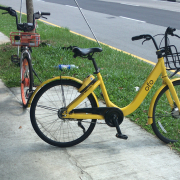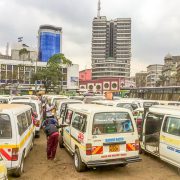Mexico City’s Rules of the Road
By Jordan Fraade, MURP ’17
Summer is the rainy season in Mexico City. When I leave my house for work every morning the sky is usually deep blue, and when I return home my trip has to be carefully timed so I don’t get caught in a torrential downpour. But as the day progresses, something else happens to the sky: a brownish layer of air gradually appears over the tops of buildings. This year, the capital has issued air-quality alerts at a rate unheard of since the 1980s, when Mexico City was ranked as the world’s most polluted city. The heavy industry that caused much of the air pollution then has largely left, but the other main culprits — motor vehicles — are still here.
Based purely on the numbers, Mexico City ought to be considered a public-transit success story. About 22 million people live in the metro area, the largest in the Western hemisphere, with 8 million in Mexico City proper. Analysts claim about 70 percent of all trips in the city are made by public transit. The Metro alone carries almost 5 million daily passengers, but covers a small portion of the region. Most public transit is managed informally: Privately owned vans and microbuses, called peseros or combis, run up and down major avenues constantly, with predictable routes and major stops listed in a placard on the front windshield.
The good news: The city’s headways are the stuff of a transportation planner’s dreams. I have never waited more than 5 minutes for a train, bus, or pesero. And the informal, highly entrepreneurial nature of the city’s informal transit system allows drivers to follow settlement patterns on the fly and adapt to changing circumstances. The bad news: Most peseros are old, dirty, and not entirely safe (although the local government is working to enforce better standards). And above all, for low-income Mexicans who live in the city’s outskirts, a commute can take hours and almost always involves at least one transfer from pesero to Metro, or one pesero to another.
This summer I am working with CTS-EMBARQ, an NGO that studies and promotes sustainable practices in urban mobility. EMBARQ has created guidelines for low-emissions development, redesigned streetscapes to be more welcoming to cyclists and pedestrians, and played a major role in the development of Metrobús, the city’s Bus Rapid Transit system. I’m particularly enthusiastic about BRT, a kind of express bus service that travels in dedicated car-free lanes, requires riders to pay fares in advance, and often runs faster than rail for a fraction of the cost. This mode of transportation is especially popular in Latin America, and I’m excited to get a more detailed look at how it operates. But more broadly, after a year at UCLA I’ve begun to see a lot of similarities between Los Angeles and Mexico City: chronic congestion, deep inequality, and a sprawling urban form that forces people to live in isolated communities and travel long distances to work.

What happens when you have too many cars in a neighborhood that was designed for people. On my walk to and from work, I often pass entire blocks of cars parked like this.
There has been a lot of discussion in the U.S. about how gentrification in urban cores could lead to the “suburbanization of poverty.” In Mexico City, where central neighborhoods are full of leafy streets and colonial buildings and the outskirts are shantytowns, that’s the status quo. This has a huge effect on transportation choices. Earlier this year a professor visited UCLA to a talk about his research in Mexico City and said, “People who are wealthy choose to live in the center, and they choose to drive.” Extreme income inequality is one of the city’s defining features, and it has led to a vicious cycle: Car ownership becomes a status symbol for the wealthy and middle class; the country’s political elite respond with urban-planning policies designed to make driving easier; the 70% of Mexico City residents who don’t drive see their well-being suffer in comparison; most of those riders “upgrade” to driving as soon as they can because they’re understandably tired of dealing with the city’s disjointed transit network.
So far I’ve learned a bit about the history of how this came to be (Carlos Hank Gonzalez, Mexico City’s unelected mayor in the 1970s, reminds me strongly of Robert Moses). Since the city won home rule in the mid-1990s, a string of left-wing mayors have tried to turn back the tide and expand transit. But the best way to see these issues play out is on the ground, in my adopted neighborhood of Coyoacán. Home to Frida Kahlo’s house, cobblestone streets, and one of the city’s most vibrant public spaces, this colonial neighborhood was swallowed up by urban sprawl in the 20th century. Since there isn’t enough room on the narrow streets for all the cars in the neighborhood, drivers simply take up space that’s not theirs. Every day on my walk home, I encounter narrow sidewalks that have been appropriated as parking spaces and blocked off entirely — forcing me to venture into the middle of the street, where stop signs and crosswalks are rarely present and speed limits are a suggestion.
I’m far from the first person to notice this. One of EMBARQ’s ongoing campaigns is dedicated to Roadway Security, a much-needed intervention in a city where an estimated 500 pedestrians are killed every year by traffic violence. Mexico City’s local government has taken steps to promote Vision Zero-style policies, and there’s even a local superhero, Peatónito, who dresses up in a lucha libre mask and helps pedestrians cross busy streets. So while many American urbanists love to look to Copenhagen or Amsterdam for inspiration, I have even more admiration for those who are fighting to change mobility culture in someplace like Mexico City — sprawling, chaotic, filled with limitless cultural and economic resources that many residents can’t access. As Los Angeles debates its own future and grapples with its autocentric culture, I’m excited to learn the tools that Mexicans are using to improve their capital and bring a few of them back home with me.











